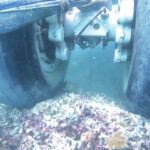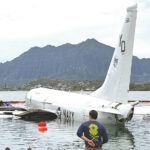US Navy plane removed from Hawaii bay after it overshot runway. Coral damage being evaluated


KANEOHE BAY, Oahu (AP) — Landing gear from a U.S. Navy jet pulverized coral when it came to a stop in an environmentally sensitive Hawaii bay after overshooting a runway nearly two weeks ago, a state official said Monday.
Kim Fuller, an aquatic biologist with the Hawaii Department of Land and Natural Resources, said divers are working to quantify the extent of the damage now that the plane has has been removed from the water.
Navy officials said Monday that a team worked through the weekend to use inflatable cylinders, or roller bags, to lift and roll the plane off the reef where it crashed on Nov. 20 and move it to the nearby runway at Marine Corps Base Hawaii at Kaneohe Bay.
Rear Adm. Kevin Lenox, the commander of Carrier Strike Group 3 who is leading the $1.5 million salvage effort, said absorbent material around the plane showed no indication of any fluid other than sea water, giving officials confidence that the plane hadn’t released any hazardous materials such as fuel.
A Navy team earlier removed nearly all of the estimated 2,000 gallons (7,500 liters) of fuel from the aircraft.
None of the nine people on board the P-8A — the military’s version of a Boeing 737 — were injured. The Navy is investigating the cause of the crash.
The Navy released underwater video last week showing the aircraft’s wheels resting on parts of crushed coral and much of the rest of the plane floating above the reef.
During a dive Sunday, state divers snorkeled along the shoreline and looked at the plane’s path into the water, Fuller said. In addition to pulverized coral at the primary impact area, there was some coral damage caused by the anchors of containment booms, she said. Some coral had also been overturned or scraped, she said.
“However, I do feel that the impact area likely is much smaller than the size of the aircraft,” she said, adding that it will take time to delineate and quantify the extent of the damage.
“I would say we’ve seen the majority of the worst damage,” she said.



